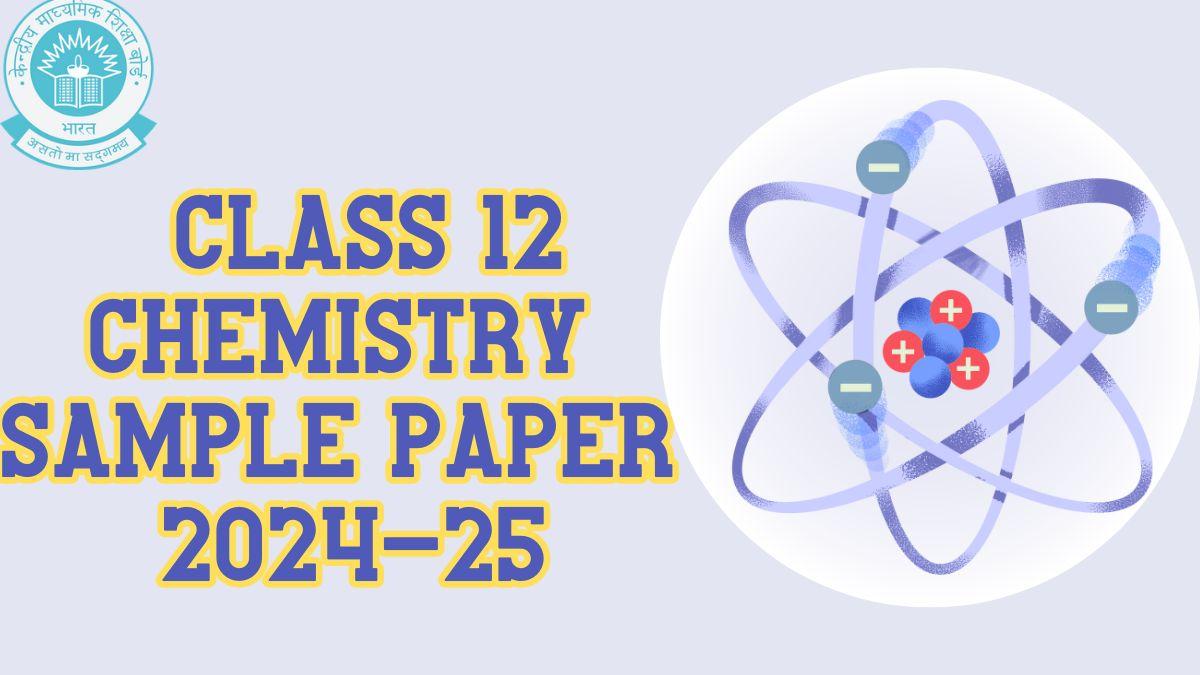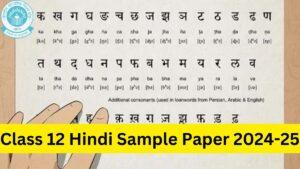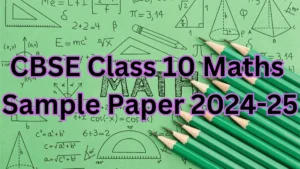Table of Contents
The CSBE has released the Class 12 Chemistry Sample Paper 2024-25 on its official website: cbseacademic.nic.in. Along with the sample paper, the marking scheme for the chemistry board exam paper and the sample paper solutions have been also published. Students who are going to take the CBSE class 12 chemistry board exam in the academic session 2024-25 can download the official Chemistry Sample Paper Class 12 2025 PDF from this article for free along with the answers.
CBSE Class 12 Chemistry Sample Paper 2024 25
As Class 12 students continue through the school year, they will discover that the Chemistry Sample Paper Class 12 2025 is a crucial resource for studying and practicing for their board exams. The class 12 chemistry sample paper 2024 25 is carefully crafted to mirror the structure and difficulty level of the board exams. Having a good understanding of the question paper format and marking scheme will enable students to tackle their study sessions with assurance and effectiveness.
Chemistry Sample Paper Class 12 2025
The subject is challenging for many students due to their difficulty in grasping the concepts. Understanding all the topics requires a considerable amount of time for them. Therefore, in order to assist them in getting ready for the board exam, we have made available the CBSE Class 12 Chemistry Sample Paper. The chemistry sample paper class 12 2025 is created by subject experts according to the updated CBSE exam pattern and revised syllabus.
CBSE Chemistry Sample Paper Class 12 2025 with Solution
Some of the important sample paper questions has been provided below. Answering these questions will provide valuable practice for students, enabling them to complete the entire Chemistry exam within the allocated time. The solutions PDF for these answers is also given below in the article.
Sample Paper Chemistry Class 12 2024-25 with Solutions PDF Download
The official Class 12 Chemistry sample paper 2024-25 has been provided below along with the marking scheme and solutions PDF. Students must solve the questions of the sample papers and later check the answers from the official solutions to understand their preparation level.
Download Sample Paper Chemistry Class 12 2024 with Solutions pdf
Download CBSE Class 12 Chemistry Marking Scheme and Solutions
Advantages of Practicing Chemistry Sample Paper Class 12 CBSE 2024-25
Students should be aware that solving the CBSE 12th Chemistry question paper for 2024, as well as practicing sample papers, can provide insight into their preparation level, the syllabus, key questions, marking scheme, and other aspects. Students have the ability to set a timer and simulate a mock CBSE 12th board exam in order to gauge their level of readiness.
Practicing CBSE Class 12 Chemistry Question Papers can lead to improved scores in the CBSE 12th Chemistry Board Exam 2025. It is advised for students to practice solving the previous year’s CBSE Class 12 Chemistry question paper to prepare for the upcoming CBSE Chemistry Board Exam. Listed below are the advantages of solving the CBSE 12th Chemistry question paper from the previous year
- Having a greater insight into the CBSE Class 12 Chemistry board exam marking scheme 2025 and exam pattern.
- Assists in monitoring significant inquiries, coverage of syllabus, preparation progress, and additional factors.
- Assists in achieving higher grades in the Class 12 Chemistry CBSE Board Exam.
- Having knowledge about the kinds of questions that will be asked in the CBSE12th Chemistry Board Exam 2025.
- Find out how ready they are for the CBSE 12th Chemistry board exam question paper in 2025.
Previous Years Chemistry Sample Paper For Class 12th with Solution
|
Previous Year’s Class 12th Chemistry Sample Paper PDF with Solution
|
|||
| Year | Subject | Sample Question Paper | Marking Scheme |
| 2023-24 | Chemistry | Click Here | Click Here |
| 2022-23 | Chemistry | Click Here | Click Here |
| 2021-22 (Term A) | Chemistry | Click Here | Click Here |
| 2021-22 (Term B) | Chemistry | Click Here | Click Here |
| 2020-21 | Chemistry | Click Here | Click Here |
| 2019-20 | Chemistry | Click Here | Click Here |
| 2018-19 | Chemistry | Click Here | Click Here |
| 2017-18 | Chemistry | Click Here | Click Here |
| 2016-17 | Chemistry | Click Here | |
| 2015-16 | Chemistry | Click Here | Click Here |





 CBSE Class 12 Hindi Sample Papers 2024-2...
CBSE Class 12 Hindi Sample Papers 2024-2...
 CBSE Class 12 Hindi Expected Question Pa...
CBSE Class 12 Hindi Expected Question Pa...
 CBSE Class 10 Maths Sample Paper 2024-25...
CBSE Class 10 Maths Sample Paper 2024-25...










